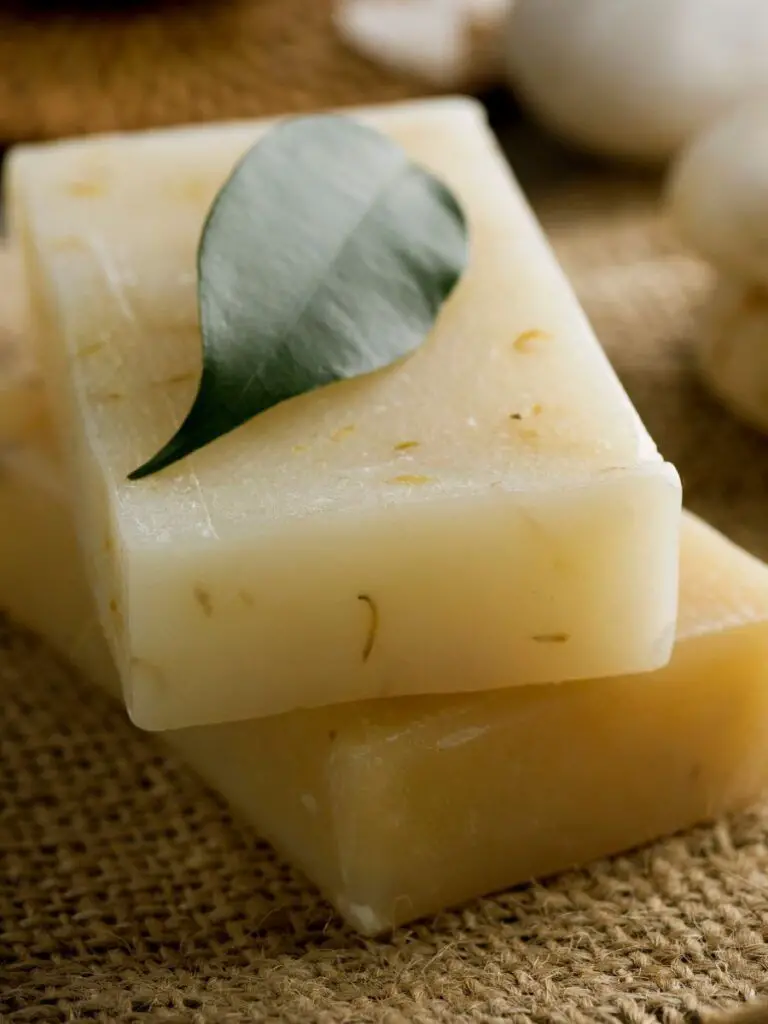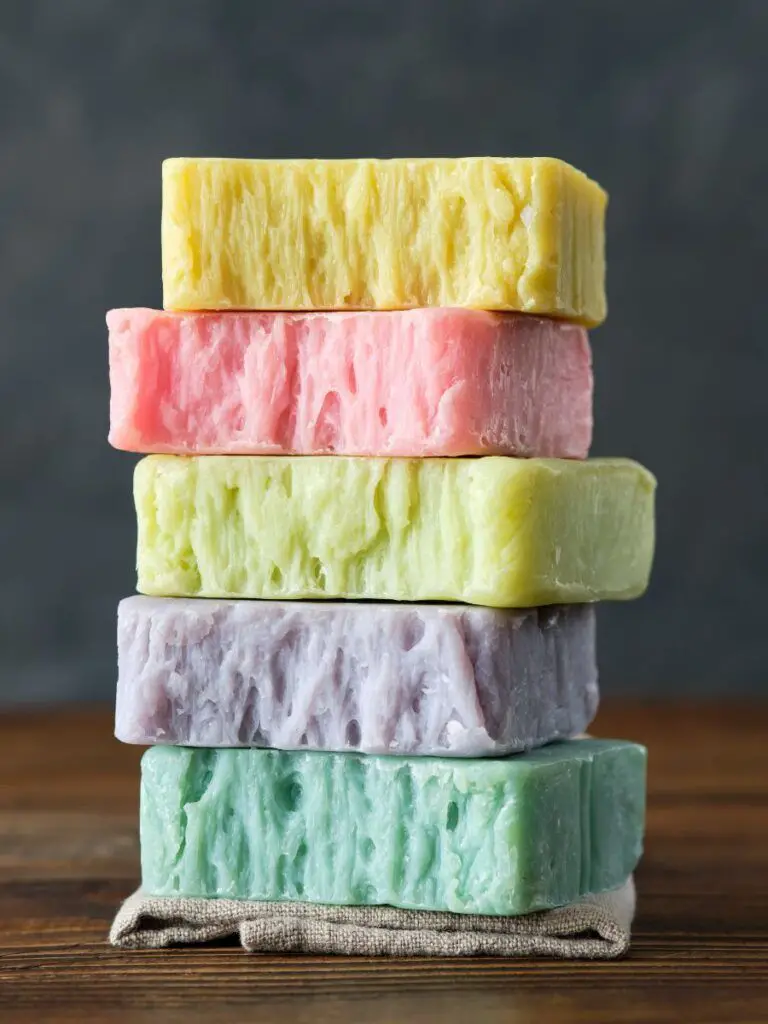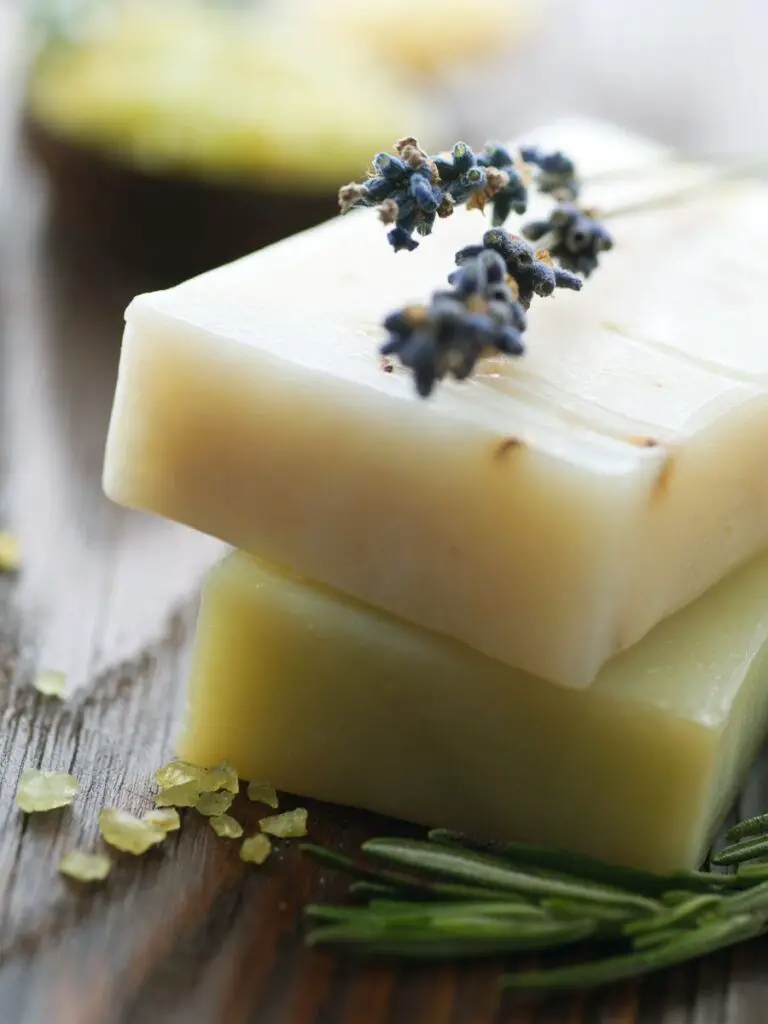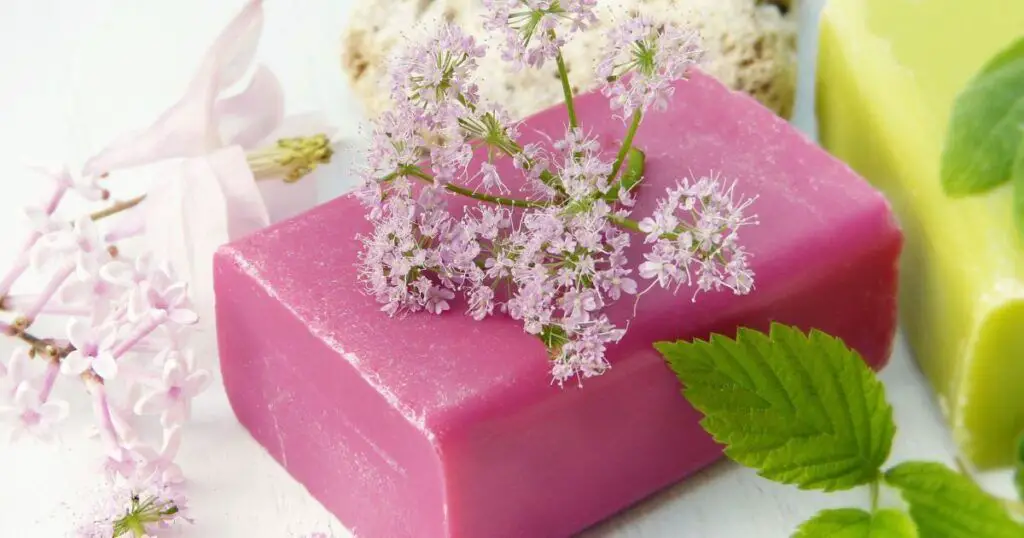As an Amazon affiliate, I may earn from qualifying purchases. Please read our Disclaimer and Privacy Policy.
I once asked a crafter how to make transparent soaps, and her answer surprised me. She made it seem like only highly trained people could make it. To be honest, she wasn’t wrong!
There is, however, a big secret to making transparent soap that I’m going to share with you in this blog post.
You can do it the “hard way” with caustic lye and risk ruining your lungs while getting a serious chemical burn. Or, hear me out, you could do it the easy way, where nobody gets hurt.
I’ll explain a little bit about how to make soap using lye, but if you’re anything like me, you may be more interested in using the “secret” method. Don’t worry. You can still create personalized, skin-loving products tailored to your preferences.
By the time you’ve finished this article, you’ll understand the importance of safety when working with lye (sodium hydroxide), the importance of precision, the chemical reaction that creates soap, and how to use your newfound confidence to play and experiment with different variations of soap.

What goes into a transparent soap base?
Unlike regular soap, transparent soap has a special recipe that includes fatty acids, coconut oil, and sodium hydroxide.
When these ingredients mix together with other vegetable oils, they create that beautiful see-through look we all love. It’s like magic in a bar of soap!
Transparent soap formulations involve creating a clear, see-through soap that looks like a colorful gem or a piece of stained glass.
Crafting transparent soap is both an art and a science, requiring a delicate balance of ingredients, temperature control, and patience throughout the process.
Unlike traditional soap bars, which are opaque, transparent soap boasts a crystal-clear appearance that showcases its natural beauty.
To achieve this clarity, soap makers often employ techniques like using lower temperatures during the soap-making process and incorporating sugar solutions into their recipes.
These additives help to dissolve any remaining soap crystals and create a smooth, transparent texture.
Additionally, incorporating natural exfoliants like dried herbs or loofah into the soap mixture can enhance its visual appeal and exfoliating properties.
Base oils such as sweet almond oil and jojoba oil, known for their moisturizing and skin-nourishing properties, form the foundation of transparent soap recipes.
Combined with fragrant essential oils and additional components like petroleum jelly or glycerin, these oils contribute to the soap’s luxurious texture and aromatic scent.
Depending on the desired outcome, soap makers may choose between the hot process method and the cold process method for crafting their transparent soap bars.
While the hot process method involves heating the soap mixture to a high temperature and accelerating the saponification process, the cold process method relies on natural curing and aging to achieve optimal results.
As the soap solution begins to take shape, soap makers can customize their creations by adding fragrance oils, dried herbs, or other botanicals.
The mixture is then poured into molds and left to cure in a cool, dry place for several weeks. During this aging process, the soap hardens and matures, resulting in a final product that is both visually stunning and indulgently luxurious.
Do you have to always use Lye when making transparent soap?
NO! There are easier ways to make transparent soap. Some of you hard-core soap makers might be more interested in working with lye, and that’s your life decision. I have a better idea for the rest of us. You’ll find it further into this post, so keep reading!
What equipment do I need to make transparent soaps?
You may already have some of the equipment required to make soap. Here is a complete list:
- Digital scale to accurately measure ingredients. Look for one that measures in grams or ounces.
- You’ll need a good-quality cooking thermometer.
- Heat-resistant mixing bowls.
- Safety gear for working with Lye. This includes safety goggles, gloves, and long sleeves.
- Stirring utensils (wooden or silicone spatulas and spoons).
- Soap molds
- Containers for mixing ingredients. Glass or plastic containers with lids work well.
- Optional stick blender (immersion blender) for quick mixing
- A flat workspace with good ventilation.
Before starting, be sure to cover surfaces with newspapers or a protective layer to catch any spills.
Making Soap Using Lye (For Daring Souls)
I just want to start out by saying that if I tried to make soap using lye, I’d have to seriously question my life choices. It’s dangerous, and I’m prone to dropping things. Making transparent soaps using lye is a delicate dance of lye, oils, and solvents.
Working with lye (sodium hydroxide or potassium hydroxide) in soapmaking carries certain risks due to its caustic nature. The potential risks include:
- Severe eye irritation
- Inhalation hazard due to the toxic fumes that are released when mixed with water or heated. Work in a well-ventilated area and wear a respirator mask.
- Chemical burns to the skin
- Corrosive to aluminum, some types of plastics, and natural fibers such as wool or silk. Avoid using lye in containers or equipment made from these materials.
- Lye must be stored in a cool, dry place, away from moisture.
Still determined to make soap using lye?
The yield of the following recipe will depend on the size of your soap mold and how thick you cut your bars. For this small batch recipe, you could expect to get about 4 to 6 bars of soap.
Ingredients:
- 200 grams Coconut Oil
- 100 grams Castor Oil
- 70 grams Sodium Hydroxide (Lye)
- 150 grams Distilled Water
- 100 grams Ethanol (95%)
- Optional: Fragrance or Essential Oil, Colorants
Equipment:
- Digital Scale
- Thermometer
- Heat-resistant mixing bowls
- Stick Blender
- Soap Mold
- Safety Gear (Goggles, Gloves, Long Sleeves)
Disclaimer:
Soap making with lye can be enjoyable, but it requires careful handling. Always wear proper safety gear and work in a well-ventilated area. Follow instructions closely, and seek professional guidance if needed. This post is for informational purposes only, and the author and publisher are not liable for any accidents or injuries that may occur.

How to Make Transparent Soaps the Hard Way (9 Steps)
Follow the next 9 steps very carefully. Have everything you need ready, and make sure you have ample workspace and a well-ventilated area. I’ve said it before, and I’ll say it again, protect your eyes and skin when working with Lye! If you haven’t read the disclaimer above, go back and read it.
Step 1: Prepare Your Workspace
Set up your workspace with all the necessary equipment and safety gear. Make sure you’re working in a well-ventilated area and have a clear understanding of the soap-making process.
Step 2: Prepare the Lye Solution
In a heat-resistant container, carefully weigh out 70 grams of sodium hydroxide (lye). In a separate container, measure 150 grams of distilled water. Slowly add the lye to the water, stirring gently until fully dissolved. Be cautious, as this mixture will heat up quickly. Allow the lye solution to cool to around 40-45°C (104-113°F).
Step 3: Prepare the Oil Mixture
In another heat-resistant container, combine 200 grams of coconut oil and 100 grams of castor oil. Heat the oils gently until melted, then allow them to cool to around 40-45°C (104-113°F).
Step 4: Combine the Lye Solution and Oils
Once both the lye solution and oils have cooled to the desired temperature, carefully pour the lye solution into the oils while stirring continuously. Use a stick blender to mix the ingredients thoroughly until you reach a light trace.
Once both the lye solution and oils have cooled to the desired temperature, carefully pour the lye solution into the oils while stirring continuously. Here’s where you have a choice: If you’re using the cold process, continue stirring until the mixture reaches a light trace.
This means it thickens slightly and begins to resemble pudding.
If you prefer the hot process, you’ll heat the mixture further after combining the lye solution and oils. This accelerates the saponification process and results in a faster cure time.
Once combined, transfer the mixture to a slow cooker or double boiler and cook until it reaches a gel-like consistency. Then, proceed to Step 5.
Regardless of the process you choose, it’s important to mix the ingredients thoroughly to ensure a successful soap-making experience. Use a stick blender if available, as it helps speed up the mixing process.
Step 5: Add the Ethanol
Gradually add 100 grams of ethanol (95%) to the soap mixture while stirring continuously. This will help dissolve any soap crystals and create a transparent appearance. Continue mixing until well combined.
Step 6: Customize Your Soap
If desired, add fragrance or essential oils and colorants to the soap mixture. Mix thoroughly until the additives are evenly distributed.
Step 7: Pour and Mold the Soap
Pour the soap mixture into your chosen soap mold. Tap the mold gently on a flat surface to remove any air bubbles. Allow the soap to cool and harden in the mold for 24-48 hours.
Step 8: Unmold and Cure
Once the soap has cooled and hardened, carefully unmold it and cut it into bars, if necessary. Allow the bars to cure in a cool, dry place for 4-6 weeks to harden and complete the saponification process.
Step 9: Lather Up!
Once cured, your transparent soap bars are ready to use or gift to friends and family. Enjoy the satisfaction of creating your own homemade soap from scratch!
Read This Before you sell your soap products
Some people may not realize there are regulations related to selling handmade artison soaps. These regulations even apply to small craft markets.
If you’re planning on selling your soap, make sure to read: 5 Selling Handmade Soap Regulations You Must Know.
Troubleshooting Your Transparent Soap Recipe
One common issue encountered when making transparent soap is cloudiness or haziness in the final product.
This can be caused by various factors, including excess oils or water content in the soap mixture. To fix this, consider adjusting your recipe to include fewer oils or lower the water content, which can help improve the clarity of the soap.
Additionally, using a crystal-clear soap base or incorporating ingredients like propylene glycol or sorbitol solution can enhance the transparency of your soap.
These additives act as solvents, helping to dissolve any soap crystals and create a clearer appearance in the final product.
Temperature control is another crucial factor to consider when making transparent soap.
Excessive heat can lead to scorching or caramelization of the soap mixture, while lower temperatures may result in slower saponification and cloudiness.
Aim for a moderate temperature range that allows for thorough mixing and saponification without overheating the mixture.
If you’re experiencing difficulties with the transparency of your soap, consider using stronger alcohol, such as isopropyl alcohol, in your recipe.
Alcohol acts as a solvent, helping to dissolve any remaining soap crystals and improve the clarity of the soap. However, be mindful of the potential effects of alcohol on skin sensitivity and fragrance retention in the final product.
Ultimately, troubleshooting transparent soap recipes requires patience, experimentation, and attention to detail.
By understanding the principles of soap making and making thoughtful adjustments to your recipe and process, you can achieve the crystal-clear soap bars of your dreams.
Don’t be afraid to try new techniques or ingredients, and remember that every batch is an opportunity to learn and improve your skills in the art of soap making.

How to Make Transparent Soap the Easy Way: Crafting Your First Batch
Making transparent soap doesn’t have to be a daunting task, especially if you’re trying it for the first time.
One easy method is to use a transparent soap base, which you can easily purchase and melt down to create your own customized bars. This approach eliminates the need to handle lye or worry about complicated processes, making it ideal for beginners or those looking for a hassle-free soap-making experience.
For your introductory recipe, let’s keep it simple yet satisfying. Here’s a basic formula to kickstart your soap making journey:
Step 1: Melt the transparent soap base in a heat-safe container
To get started, all you need is a transparent soap base, which typically contains ingredients like stearic acid to help create the transparent appearance of the soap. Simply chop the soap base into small pieces to speed up the melting process.
Then, place the pieces in a heat-resistant container and melt them down using a double boiler or microwave.
Step 2: Pour the soap mixture into molds lined with plastic wrap to create your desired shapes
Stir the melted soap base thoroughly to ensure that the additives are evenly distributed throughout the mixture.
Next, prepare your soap molds by spraying them lightly with rubbing alcohol to help prevent air bubbles from forming. Then, carefully pour the melted soap base into the molds, taking care not to spill any.
To achieve the best results, you can also spritz the surface of the poured soap with a little bit of hot water to help smooth out any imperfections or bubbles. This will give your transparent soap bars a professional-looking finish.
Step 3: Allow the soap to cool and harden at room temperature, or in the refrigerator, for a quicker set
Allow the soap to cool and harden in the molds for several hours or overnight. Once fully cooled, you can unmold your transparent soap bars and admire their beautiful appearance. With just a few simple steps, you can create your own stunning transparent soap bars that are perfect for gifting or pampering yourself.
Step 4: Once solidified, carefully remove the soap bars from the molds and admire your handiwork!
Congratulations! You’ve made your first batch of soap without chemical burns!
You Might Like This:
37 Best Adult Games For Over 50 Crowds
69 Best Mind-Stimulating Hobbies For Men Over 60
23 Ultimate Hobbies for People Over 50 to Enjoy
Soapy Summary
Whether you’re a seasoned soap maker or new to the art of crafting, transparent soap offers endless possibilities for creativity and self-expression.
With its unique blend of vegetable-based oils, natural exfoliants, and aromatic fragrances, transparent soap invites you to embark on a journey of sensory delight and self-care.
So grab your glass jar, potato masher, and liquid soap solution, and let the magic of transparent soap making unfold before your eyes.

